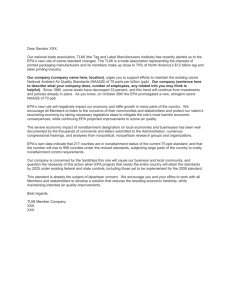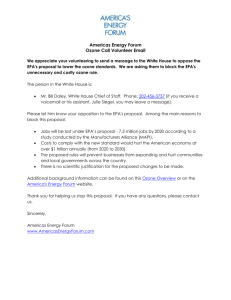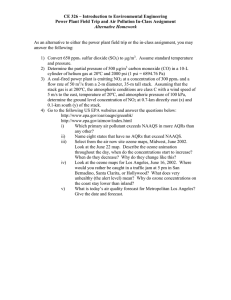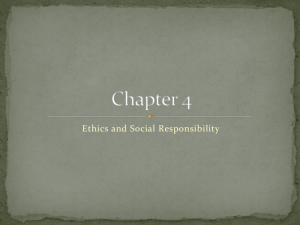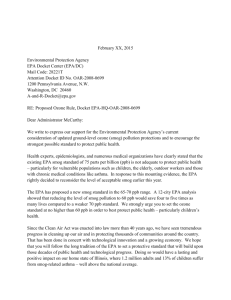EPA Proposes Update to National Ambient Air
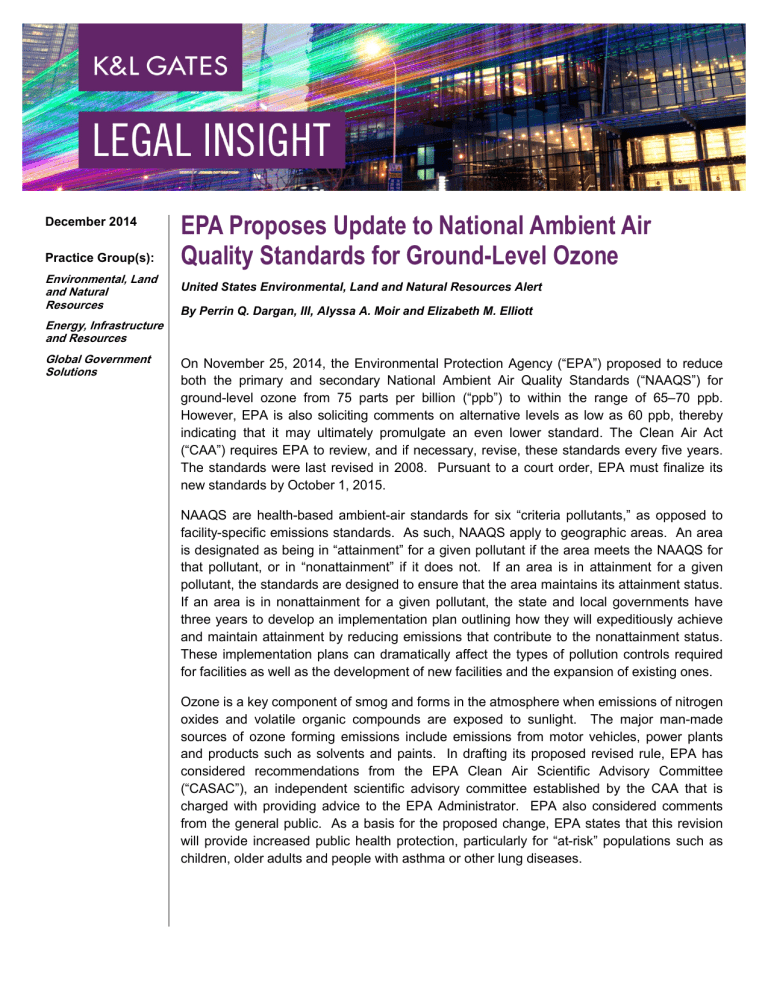
December 2014
Practice Group(s):
Environmental, Land and Natural
Resources
Energy, Infrastructure and Resources
Global Government
Solutions
EPA Proposes Update to National Ambient Air
Quality Standards for Ground-Level Ozone
United States Environmental, Land and Natural Resources Alert
By Perrin Q. Dargan, III, Alyssa A. Moir and Elizabeth M. Elliott
On November 25, 2014, the Environmental Protection Agency (“EPA”) proposed to reduce both the primary and secondary National Ambient Air Quality Standards (“NAAQS”) for ground-level ozone from 75 parts per billion (“ppb”) to within the range of 65–70 ppb.
However, EPA is also soliciting comments on alternative levels as low as 60 ppb, thereby indicating that it may ultimately promulgate an even lower standard. The Clean Air Act
(“CAA”) requires EPA to review, and if necessary, revise, these standards every five years.
The standards were last revised in 2008. Pursuant to a court order, EPA must finalize its new standards by October 1, 2015.
NAAQS are health-based ambient-air standards for six “criteria pollutants,” as opposed to facility-specific emissions standards. As such, NAAQS apply to geographic areas. An area is designated as being in “attainment” for a given pollutant if the area meets the NAAQS for that pollutant, or in “nonattainment” if it does not. If an area is in attainment for a given pollutant, the standards are designed to ensure that the area maintains its attainment status.
If an area is in nonattainment for a given pollutant, the state and local governments have three years to develop an implementation plan outlining how they will expeditiously achieve and maintain attainment by reducing emissions that contribute to the nonattainment status.
These implementation plans can dramatically affect the types of pollution controls required for facilities as well as the development of new facilities and the expansion of existing ones.
Ozone is a key component of smog and forms in the atmosphere when emissions of nitrogen oxides and volatile organic compounds are exposed to sunlight. The major man-made sources of ozone forming emissions include emissions from motor vehicles, power plants and products such as solvents and paints. In drafting its proposed revised rule, EPA has considered recommendations from the EPA Clean Air Scientific Advisory Committee
(“CASAC”), an independent scientific advisory committee established by the CAA that is charged with providing advice to the EPA Administrator. EPA also considered comments from the general public. As a basis for the proposed change, EPA states that this revision will provide increased public health protection, particularly for “at-risk” populations such as children, older adults and people with asthma or other lung diseases.
EPA Proposes Update to National Ambient Air Quality Standards for Ground-
Level Ozone
Implications of Proposed Standards
Attainment Implications
Should EPA’s current proposed rule be finalized, many areas of the United States that are currently in attainment will likely be reclassified as non-attainment. According to the Los
Angeles Times , “[o]f the 715 counties nationwide with EPA-certified air quality monitoring equipment, 185 do not meet the existing ozone standard,” and that number would “more than double if a stricter limit of 70 parts per billion were in effect today.”
Of course, those areas that are unable to meet the current standards would face even steeper challenges to reach attainment under the proposed lower standard. Some states with nonattainment areas, particularly California, project that they will not be able to meet the current standard until
2032, and only then by cutting more than 75% of the nitrogen oxides being produced in areas with particularly severe ozone problems such as Los Angeles and Orange counties.
Under the proposed rule, these areas would have until 2037 to meet the new standard.
Cost Implications
In an effort to meet the new standard, states will likely impose stricter pollution controls on power plants and other emitting industries. The National Association of Manufacturers expressed concern that the proposed standard “could jeopardize recent progress in manufacturing by placing massive new costs on manufacturers and closing off counties and states to new business by blocking projects at the permitting stage.”
The American
Petroleum Institute predicts that the proposed standard could reduce U.S. GDP by $270 billion per year.
EPA counters with projections that show that most counties in the U.S. will meet the proposed standards by 2025 with the rules and programs currently in place.
The agency further asserts that a combination of recently finalized or proposed air pollution rules will cut ozone-forming emissions from industry and transportation, helping areas meet the proposed standards. For example, for stationary sources, EPA’s 2005 Clean Air Interstate Rule
(“CAIR”) reduces ground level ozone in the east by permanently capping emissions of sulfur dioxide and nitrogen oxides, and the 2011 Mercury and Air Toxics Standards reduce emissions of sulfur dioxide and fine particles. Examples of current rules governing mobile sources include the 2014 Tier 3 Motor Vehicle Emission and Fuel Standards, which proposes to set new vehicle emissions standards and lower the sulfur content of gasoline
1
“EPA expected to propose stricter ozone limits,” Los Angeles Times , November 25, 2014.
2
“EPA staff recommends significantly lower ozone standard,” Los Angeles Times , August 29, 2014.
3
“New Ozone Regulation Jeopardies Manufacturing Comeback,” National Association of Manufacturers, November 26,
2014.
4
American Petroleum Institute, citing study by NERA Economic Consulting at http://www.api.org/policy-and-issues/policyitems/environment/economic-impacts-of-ozone-regulations .
5
EPA “Overview of EPA’s Proposal to Update the Air Quality Standards for Group-Level Ozone,” available at http://www.epa.gov/airquality/ozonepollution/pdfs/20141125fs-overview.pdf.
2
EPA Proposes Update to National Ambient Air Quality Standards for Ground-
Level Ozone beginning in 2017, and corporate average gasoline sulfur standards which reduced the sulfur content of fuel in both 2004 and 2006.
EPA estimates that annual compliance costs would be $3.9 billion for a 70 ppb standard and
$15 billion for a 65 parts per billion standard. However, the Agency concludes that these costs would be outweighed by significant health benefits, which it values at $6.4 to $13 billion annually in 2025 for standard of 70 ppb and $19 to $38 billion annually in 2025 for a standard of 65 ppb nationwide, excluding California.
Industry Implications
A considerable amount of the cost of meeting the proposed NAAQS will likely fall on emitting industries such as power plants, coal mines, petroleum and natural gas wells. Vehicle emissions will also likely be impacted. According to the National Association of
Manufacturers, the new regulation “threatens to be the most expensive ever,” due in part to the fact that it “comes at the same time dozens of other new EPA regulations are being imposed that collectively place increased costs, burdens and delays on manufacturers, threaten our international competitiveness and make it nearly impossible to grow jobs.”
Costs will likely include increased price of electricity and installation of new and expensive technology designed to clean pollutants and reduce emissions from their facilities.
States will also need to limit permits for new and expanding manufacturing and construction operations in an effort to remain compliant with the new ozone regulations.
In areas where vehicle emissions are key contributors to ozone, achieving the pollution reduction needed to meet the new standard could require a large-scale transformation of the transportation sector, including advances in alternative-fuel cars and trucks and cleaner ships, trains and construction equipment, or the imposition by local regulation of “transportation demand management” initiatives, seeking to reduce or limit automotive and truck transportation.
How to Comment
The agency will receive comments on the proposal for 90 days following publication in the
Federal Register and will hold three public hearings, with an aim to issue final ozone standards by October 1, 2015. The EPA will hold three public hearings in January 2015, the
6
Other current rules that will reduce ozone-forming emissions include regional haze regulations, the proposed Clean
Power Plan, the Tier 2 Vehicle Emissions Standards, the Mobile Source Air Toxics Rule, the Heavy-Duty Vehicle
Greenhouse Gas Rule, the RICE NESHAP and the Industrial/Commercial/Institutional Boilers and Process Heaters MACT and amendments.
7
EPA analyzed the benefits and costs for California separately because a number of areas in California will have longer to meet the proposed standards. In California, EPA estimates that the added value of benefits would be $1.1 to $2 billion annually for a standard of 70 ppb and $2.2 to $4.1 for a standard of 65 ppb.
8
“New Ozone Regulation Jeopardizes Manufacturing Comeback,” National Association of Manufacturers, November 26,
2014, available at http://www.nam.org/Newsroom/Press-Releases/2014/11/New-Ozone-Regulation-Jeopardizes-
Manufacturing-Comeback/.
9
“New EPA Ozone Regulations Could Be Troublesome for Manufacturers,” Manufacturing Business Technology,
December 4, 2014, available at http://www.mbtmag.com/blogs/2014/12/new-epa-ozone-regulations-could-betroublesome-manufacturers .
10
Id.
3
EPA Proposes Update to National Ambient Air Quality Standards for Ground-
Level Ozone details of which have not yet been announced. For more information on submitting comments, see www.epa.gov/airquality/ozonepollution/how-to-comment.html
.
Authors:
Perrin Q. Dargan, III perrin.dargan@klgates.com
843.579.5637
Alyssa A. Moir alyssa.moir@klgates.com
206.370.7965
Elizabeth M. Elliott elizabeth.elliott@klgates.com
843.579.5676
Anchorage Austin Beijing Berlin Boston Brisbane Brussels Charleston Charlotte Chicago Dallas Doha Dubai Fort Worth Frankfurt
Harrisburg Hong Kong Houston London Los Angeles Melbourne Miami Milan Moscow Newark New York Orange County Palo Alto Paris
Perth Pittsburgh Portland Raleigh Research Triangle Park San Francisco São Paulo Seattle Seoul Shanghai Singapore Spokane
Sydney Taipei Tokyo Warsaw Washington, D.C. Wilmington
K&L Gates comprises more than 2,000 lawyers globally who practice in fully integrated offices located on five continents. The firm represents leading multinational corporations, growth and middle-market companies, capital markets participants and entrepreneurs in every major industry group as well as public sector entities, educational institutions, philanthropic organizations and individuals. For more information about K&L Gates or its locations, practices and registrations, visit www.klgates.com
.
This publication is for informational purposes and does not contain or convey legal advice. The information herein should not be used or relied upon in regard to any particular facts or circumstances without first consulting a lawyer.
© 2014 K&L Gates LLP. All Rights Reserved.
4

